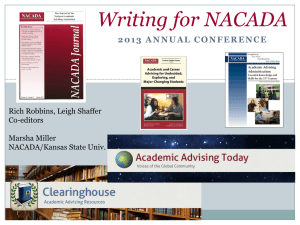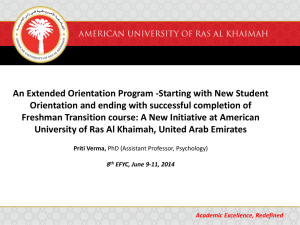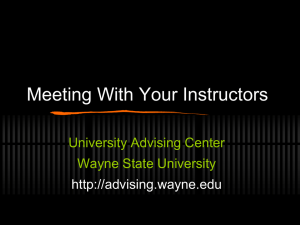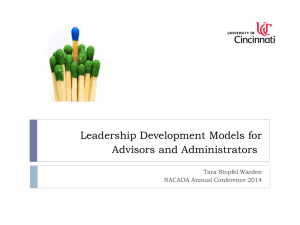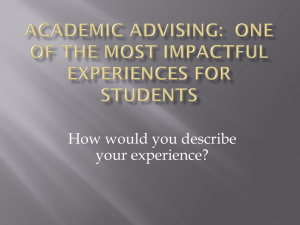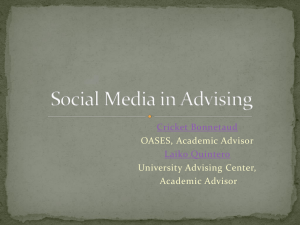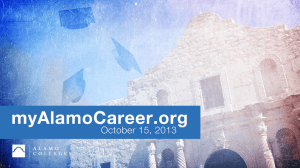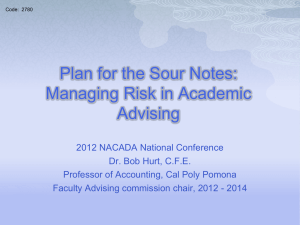Essentials of Writing for the NACADA Journal
advertisement
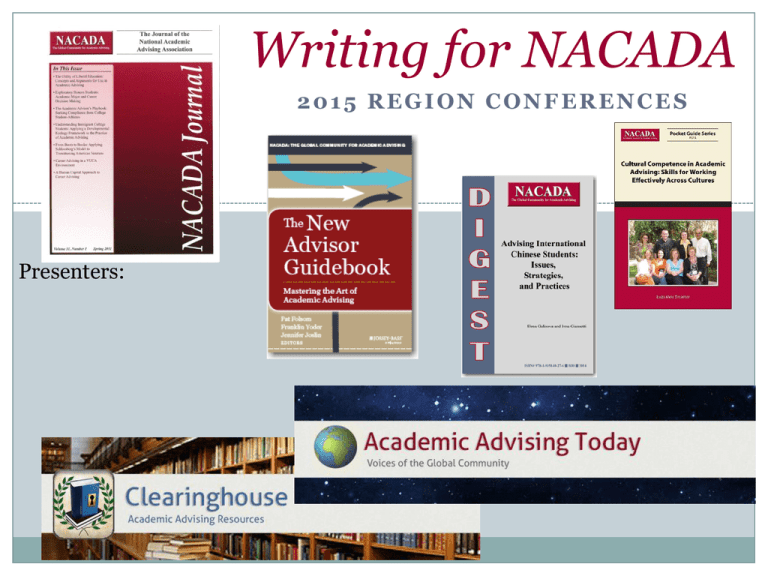
Writing for NACADA 2015 REGION CONFERENCES Presenters: NACADA Publications 170+ individuals wrote for NACADA venues in 2014 The NACADA Journal Academic Advising Today Clearinghouse of Academic Advising Resources NACADA books Pocket Guides NACADA Blog What we’ll talk about today… Purpose Content Writing Guidelines Acceptance Process How do I get published…? What would you like to add to the literature? Write down at least one idea you have for writing about an advising related issue NACADA Publications Philosophy Research, theory, and practice Research qualitative research quantitative research mixed methodology Theory applying existing theory to academic advising developing new theory relevant to advising Advising Practice Journal Purpose • Professional publication Blind-reviewed Peer-refereed • Published biannually • Scholarly articles on research, theory & practice • Book reviews The NACADA Journal exists to advance scholarly discourse about the research, theory, and practice of academic advising in higher education. NACADA members receive a print copy. All articles can be accessed at www.nacadajournal.org. Download the mobile app! Journal Guidelines Manuscripts should not exceed 6,000 words (excluding title page, abstract, and references) Most articles based upon IRB approved research that uses standard qualitative or quantitative research methodology or discussion of theory Journal and APA style guides NACADA online guide page Publication Manual of the American Psychological Association, Sixth Edition Journal Recent Titles www.nacadajournal.org Journal Acceptance Process Co-Editors read each manuscript and decide if a blind copy should go to Manuscript Reviewers Co-Editors reserve right to work directly with authors if significant revision is needed before blind review OR if manuscript is near publication form Three Manuscript Reviewers from the Editorial Board read article and write an independent review Co-Editors read reviews and re-read manuscript Co-Editors write an Editorial Decision Letter Decisions: Accept, Revise study/manuscript, Reject Approximately 30% of manuscripts are published What happens during the review process? Manuscript review normally takes three to four months Reviewers can suggest that a manuscript be accepted, revised and resubmitted, or rejected Editors write authors letters sharing reviewer feedback and making constructive suggestions Majority of authors are asked to revise and resubmit based upon reviewer comments Average article is revised two times before acceptance Once accepted, manuscripts are published on a rolling basis twice a year: usually June and December What happens after acceptance? Developmental copy editing process Authors sign copyright release to begin editing process Accepted manuscripts sent to Nancy Vesta, NACADA Copy Editor Edits Clarify meaning Eliminate jargon Check mechanics Check internal consistence of facts Brings manuscript into APA compliance Editing process takes ~three months Author receives edited manuscript with queries where needed Authors return manuscript to Copy Editor within ~10 days How do I get an article published in the Journal? Formulate your idea Professional reading, colleague discussion, glean from practice Investigate the idea Conduct qualitative and/or quantitative research - OR Study theory and apply to advising practice – OR Formulate new theory that can applied to advising practice Prepare a manuscript that: Follows author guideline in Journal section of www.nacada.ksu.edu Is compliant with 6th edition of Publication Manual of the American Psychological Association Includes implications for advising practice Upload “clean” manuscript & cover sheet following directions at www.nacada.ksu.edu/Resources/Journal/Publication-Guidelines.aspx How do I get an article published in the Journal? TIPS: Become familiar with the NACADA Journal Types of articles Tone and style of writing Place your article in the context of previous Journal articles on your topic If writing based upon dissertation: follow chapter in 5th edition of APA manual Proofread to assure you are really finished Follow the submission process and published guidelines on Journal website Follow the 6th edition APA Style Guide (no hybrid styles) “Clean” manuscript for blind review; use cover sheet for identification information Learn from the review process; schedule time to revise and then do it! Sign copyright release to move accepted manuscript to copy edit phase Provide contact information for administrator who receives Journal copy NACADA Journal Book Review Online in Journal section of NACADA website Reviews are good starting place for new authors Members may review once each year List of available books on web (see URL below) Become familiar with book review sections: Choosing and requesting a book Writing and submitting the review Web published book reviews from past Journal issues E-letter sent to administrator of choice One review featured in each print issue; rest published to http://www.nacada.ksu.edu/Resources/Journal/Book-Reviews.aspx Academic Advising Today December 2014 issue AAT Purpose Quarterly electronic publication (e-pub) Juried but not blind review Venue for academic advisors and advising administrators to share experiences Discuss ideas about theory and practice of academic advising in higher education AAT Content Practical application of theory or research Popular venue for practice-based articles based upon conference presentations Includes – President’s column – Exec Director’s column – Member articles – Keynotes / Guests – Vantage Points – Commission-sponsored articles AAT Guidelines Ideal submission: balanced in perspective educational in nature positive in tone focused on a particular aspect of academic advising ~1200 words not counting reference citations Ask yourself: What implications does what I want to say have for advising practice? Devote the majority of the article to providing details that illustrate how an aspect of advising is useful AAT Guidelines Write in the 3rd person (advisors should…) or 1st person (we should…) 2nd person (you should…) will not be accepted Use Publication Manual of the American Psychological Association, 6th edition for citation guidelines Commercial messages and promotions are not accepted; submissions must be both product- and vendor-neutral Articles printed elsewhere cannot be reprinted in AAT without written permission from the original publication AAT Acceptance Process Submit your article via e-mail to Leigh@ksu.edu Identify yourself by name, position title, department, institution, and e-mail address Juried (not generally blind) review Draft acceptance rate ~ 60% Copy edit on campus, NACADA proofs to finalize Photo and Copyright release required Most articles printed within 3-6 months Clearinghouse Purpose / Content Promote the advancement of academic advising by providing members with electronic access to: Advising Issues & Resources Anchor/overview article Resource links to related Web sites and articles Pillar documents for academic advising links to recognized definitions, standards, and values of advising Member Produced Handbooks & Web Publications suggested by NACADA members as useful Clearinghouse Guidelines Juried (not blind) publication ‘Wikipedia’ for advisors Clear, concise, and to-the-point overview of a 'Critical Issue' within advising (note: not advising practice at one institution) Article can be read in 5 minutes ~ 1600 words Written in 3rd person Includes resources to “read more about” the topic and questions to discuss APA format Copyright release Clearinghouse Articles Your task: Find and write on a topic either not covered in the Clearinghouse or in need of an update. How do I get an article published in the Clearinghouse? Have an idea Check the Clearinghouse at to see what already has been said about this issue Consider what else needs to be said, what research or theory should be cited, what resources should be linked, and what questions could be discussed Email publish@ksu.edu to discuss possible article Write it Submit it Have article accepted, copy edited, and posted Additional NACADA publication opportunities Books Digest book Pocket Guides Blogs Additional NACADA Publication Opportunities NACADA-produced books Book partnerships with Jossey-Bass and National Center for the First-Year Experience and Students in Transition (FYE) Opportunities to be involved Editors Chapter authors Content Review Panel members How to become an author Call for author sent to applicable Commission/Interest Group authors previously written on the topic in other NACADA venues Members who have presented preconference workshop on the topic Send application with two writing samples New authors are encouraged to apply! New authors often paired with seasoned authors to co-author chapter. Reviewer opportunities What is reviewed? 1st drafts written for NACADA-produced books and Digest offerings NACADA books currently in print that are 6+ years old Who reviews? Members knowledgeable on the topic Previous writing experience is helpful but not required Upcoming review opportunity: Advising Students with Disabilities to determine if a revision is needed. Email publish@ksu.edu by May 15 to review this summer NACADA Pocket Guides • • • • ~ 8500 Words Practice-based, “hot” topics in the field See current topics at the NACADA Exhibit Booth Sample topics: • Foundations of academic advising • Advising Students on Probation • Advising at-risk students • Persistence and completion • Advising undecided students • Have an idea: Contact Leigh Cunningham at leigh@ksu.edu Digest books 6 x 9” format Smaller (~30,000 words) than NACADA books (~125,000 words). Bigger than Pocket Guides (~8500 words) Shorter writing time than books One topic One (or two) authors write the Digest Published both in print and as e-pub Contact publish@ksu.edu with ideas Submissions should be: About an advising/student success related NACADA experience. Educational in nature, positive in tone, and focused on particular aspects of academic advising. Original and written especially for the NACADA blog. Both product- and vendor-neutral. Non-political Writing Guidelines Keep posts to the point, roughly 250-400 words in a Word file. http://nacada.wordpress.com/ Use the first person singular. Writing in a conversational tone engages readers and we like hearing personal stories. When possible, include at least one image in your post. contact nblog@ksu.edu Try to utilize a bulleted format and urls when appropriate (be sure to state where user is going with url). How to get started Become familiar with venue guidelines Read, Read, Read… everything you can on topic Make notes and citations as you read Invite collaborators/reviewers Set a time & place to write Give yourself a deadline Brainstorm ideas and delineate points Review NACADA Writing Checklist on Writing for NACADA website Write and review. Let colleagues read drafts Take drafts to campus writing center. Revise based upon feedback and submit! What will you write? What topic? What venue? Complete the “Writing for NACADA” interest form at http://bit.ly/1njfE7e or Give presenter your business card with your idea and venue on the back tp have a NACADA graduate student send you the URL. Summary/Quiz • Where would you send a scholarly article based on formal (IRB approved) inquiry? • Where would you send an article based on your advising experience? • Where would you send an idea for a yet-to-be published topic? • Where would you send an idea based on research or theory that will improve advising practice? Questions
